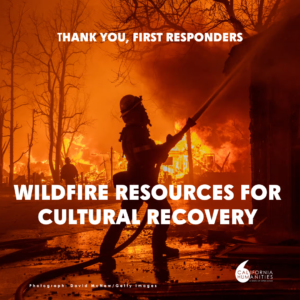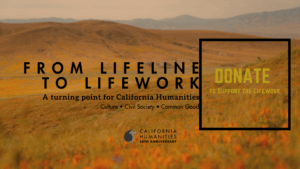A single traveling exhibit from Exhibit Envoy’s repertoire, including those funded by California Humanities, can reach thousands of new people up and down California, from Visalia to Redding to San Diego. The nonprofit’s Executive Director, Amy Cohen, recently sat down with California Humanities’ Kerri Young and Felicia Kelley to discuss how these exhibits are enabling Californians to learn about our states’ complex history, diverse cultures, and unique environment.
This interview originally took place in-person at Swan’s Market in Oakland, California on July 10, 2023. It has been edited for length and clarity.

KY: Can you tell us about Exhibit Envoy and what it is that you do there?
AC: Exhibit Envoy is a nonprofit that creates and travels exhibits for small museums, libraries, and cultural centers, mostly across California, but also across the US. I’m the Executive Director, one of two staff members there. I handle a lot of different activities, whether it’s exhibit development, exhibit design, grant writing, marketing, dealing with shippers, handling fabrication and crating – all of the administrative and exhibition tasks you can think of!
In general, our exhibits look at the art, history, natural history, and cultural character of California. We share stories about everything from the California grizzly bear, to pollinators, from women in tattoos before World War II to stories of unhoused people, from migrant farmworkers experiences to textile artworks, to seaweed, to African American portraiture in the early 20th century. We use the arts and humanities as a lens for almost every story that we share, and our goal is to help explore as many different California stories as possible.
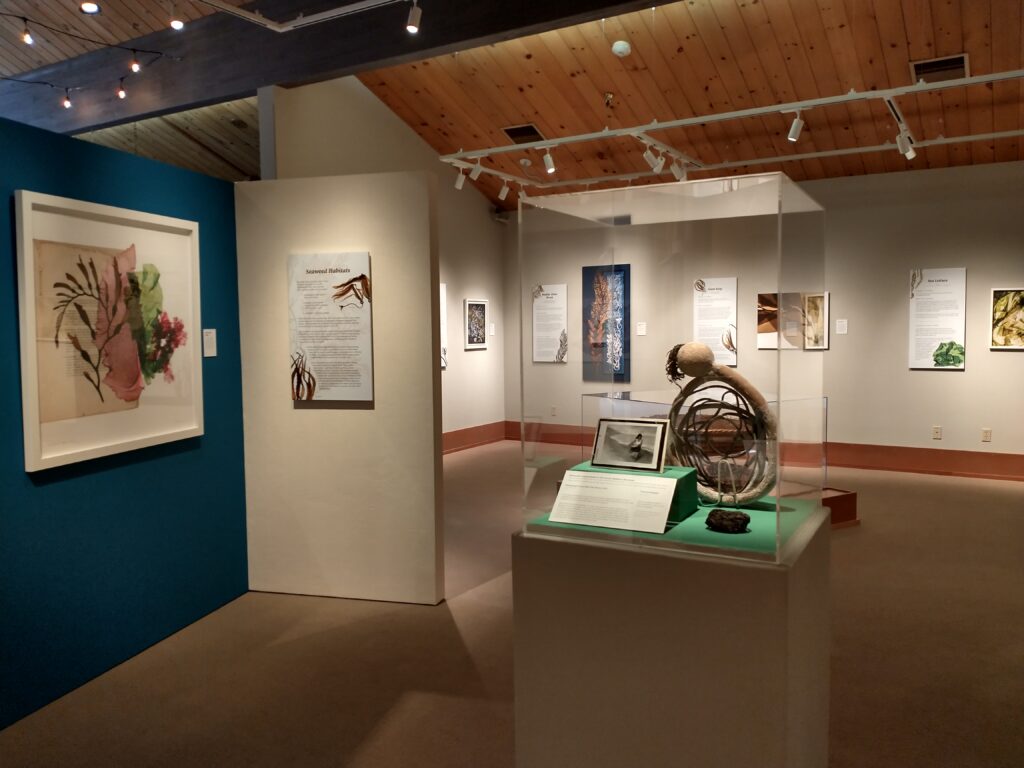
KY: Can you tell us a little bit about the history of Exhibit Envoy with California Humanities?
AC: Exhibit Envoy actually evolved from an earlier project of California Humanities, the Rural Museum’s Consortium, which launched in 1988 in order to share resources and exhibits. Its mission was to serve the needs of small museums that did not have the capacity to develop in-house temporary exhibitions and could not afford to rent them from large traveling exhibition companies.
After that, the Rural Museum’s Consortium changed names, and it became an independent nonprofit in 2002 called the California Exhibitions Resource Alliance. Folks who have been in the field for a while may remember CERA, as it was commonly called. As that independent nonprofit, CERA continued to tour exhibits around California, and then in 2011 rebranded to become Exhibit Envoy.
At this point, we’ve been around for about 35 years now, which is pretty amazing.
KY: Why would you say that traveling exhibits are a popular and effective way to deliver humanities experiences to the public?
AC: That is a great question. For me, there are two main reasons. The first is that it allows museums and artists and cultural practitioners and institutions to pool their resources to share broader California stories.
So, instead of having ten different museums all working on the same thing, using their staff time, having to pay for fabrication, and then trashing or recycling an exhibit when it’s done, instead everyone works together to create one exhibit that then can tour. You’re using everyone’s resources effectively.
That’s on the museum or staff side. But then in terms of the public, you know, it really helps distill humanities scholarship in a way that is engaging and accessible for the general public. There are so many interesting humanities projects that are going on, and so much good research out there! A traveling exhibit can take all of that amazing information, distill it into something that’s engaging and educational and easy to understand, and then bring those stories around the state to reach as many people as possible.
FK: Could you say something about the format of the traveling exhibit, for people who may not know what it looks like?

AC: At Exhibit Envoy, we work with a number of different small and mid-size institutions with different needs. Because of that, we have a variety of exhibits traveling in a variety of formats.
Some of our traveling exhibits are what you would expect to see in a museum gallery. There will be original artwork, text panels, interactive components, audio visual elements, objects and original artifacts with higher security needs (and sometimes reproduction artifacts that can be hands-on as well). And then other institutions that we partner with have very non-traditional gallery spaces or even no gallery space at all! Because of that, we also tour exhibits that are simply free standing. For example, we have pop-up banners that are really easy to install, say, in the lobby of a government building or in a library. It’s safe for the public to interact with, even if there’s no staff watching in the gallery space, but still gives visitors the chance to engage with important California stories.
With all of these exhibits, of course, we provide press kits and publicity images, exhibit manuals, programming and resource suggestions, and installation instructions, so the folks who are hosting know what to expect.
KY: What is one of the most impactful exhibits that Exhibit Envoy has taken on?
That is a really hard question, because each exhibit can mean something to visitors based on their personal experiences, the region in which they live, or even the people they’re viewing the exhibit with. So one exhibit that could be super popular and impactful at one location, may not be at another and vice versa.
One exhibit that comes to mind is actually one that California Humanities funded through a different organization, Cal Ag Roots at the California Institute for Rural Studies, and that we collaboratively developed with Susan Anderson of the California African American Museum; the California Historical Society; and Dr. Caroline Collins from UC San Diego: We Are Not Strangers Here: African-American Histories in Rural California. That exhibit is still touring, and is a free-standing banner exhibit. This makes it really easy for folks who don’t necessarily always host exhibits, like state parks, to be able to display the show. There’s also a slightly reworked version of the exhibit opening at the California African American Museum in Los Angeles in early August. Susan Anderson, who was the humanities advisor for the project, is now the Curator of History there.

What I’ve heard from institutions who hosted this show is that Black or African American visitors often comment that it’s amazing to see their histories represented. At the same time, folks who are not Black or African American often say, “I didn’t even know this history existed, I didn’t realize how diverse rural California has always been.” And so this has been a really great exhibit for us because it’s sharing overlooked histories and making a real impact on visitors.
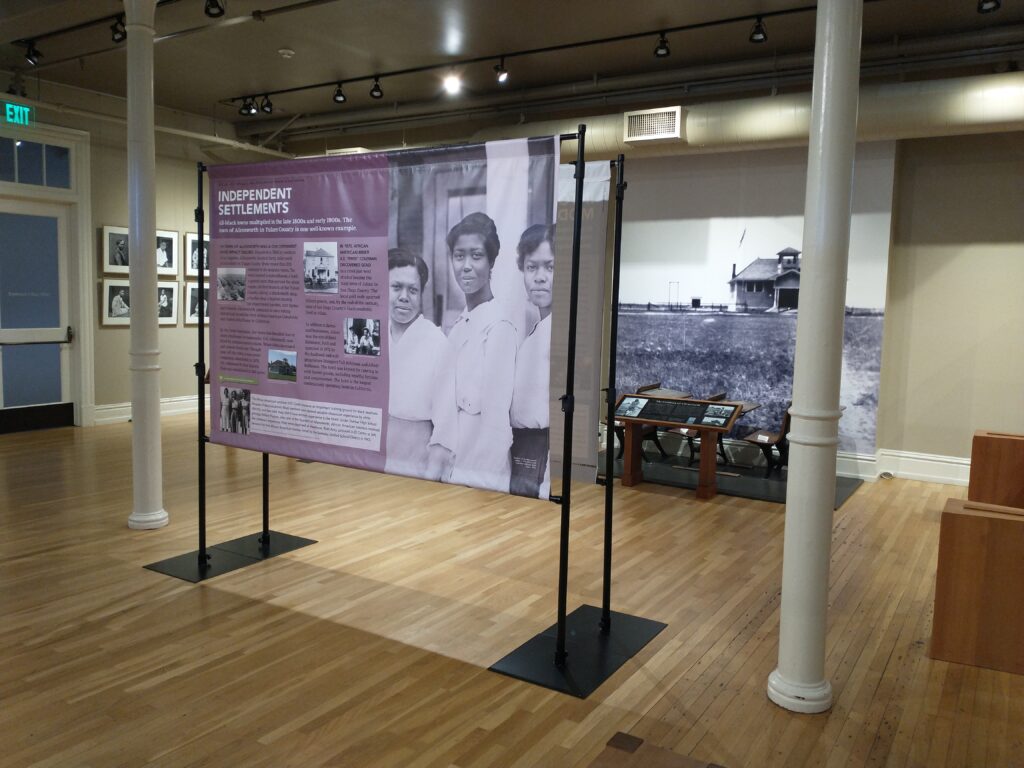
“We Are Not Strangers Here” on display at the Society of California Pioneers in San Francisco.
Exhibit Envoy
“We Are Not Strangers Here” on display at the Society of California Pioneers in San Francisco.
Exhibit Envoy
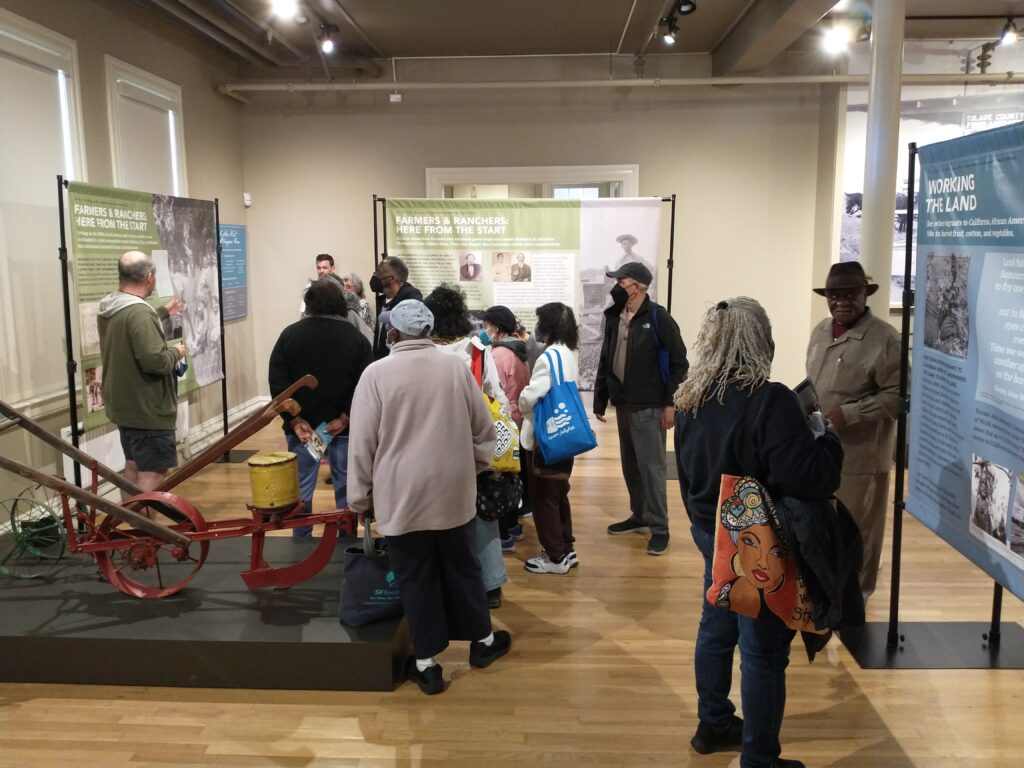
This exhibit is also a great example of the places we partner with, as it has been exhibited all across California: the Society of California Pioneers in San Francisco, the San Joaquin County Historical Society and Museum in Lodi in the Central Valley, the Tulare County Museum in Visalia, the San Diego Public Library, the Milpitas Library, Colonel Allensworth State Historic Park, San Luis Obispo Coast District of California State Parks, the Sutter County Museum in Yuba City, the Shasta Historical Society in Redding, and, right now, at the Healdsburg Museum in Sonoma County.
But I think that also underscores, you know, your question earlier about why these traveling exhibits are effective. None of these institutions had to invest their time and resources into doing all of this research in a silo. Instead, they can take their time to form community connections or partnerships, or augment the show with stories that are local to their communities, which almost all of these institutions did. The banners anchored all of these augmented components, and museums brought in even more original objects and artifacts, more photographs, and local stories.
It’s inspiring how much history folks have been able to incorporate into this exhibit. Our museum and library partners, they’re just amazing. I will sing their praises all day!
KY: If an institution in California is interested in hosting one of your exhibits, what is the process, what’s your advice for institutions that are interested and not sure if they could handle something like this?
AC: If [an institution] is not sure if an exhibit will work for them, they can just reach out to us directly.
We’re really happy to share any information about an exhibit that would be helpful, because we want everybody to be happy and know exactly what they’re getting into. I certainly have phone calls and emails from folks all the time saying, “this is what our gallery looks like. This is part of our facility report, can we host this show?” And I might say, “You know what? The security requirements might not be a good fit, but what about this show or that show that really fit with the themes you’re talking about?” Our goal as a nonprofit and as an art service organization is to make the hosting process as easy as possible.
In terms of the booking process, we do charge a small rental fee for each of our exhibits; that’s where about 90% of our revenue comes from each year. After you tell us what dates you want to host a show, then we move forward with a 25% deposit and a contract, send you all the PR materials, the exhibition scripts, the object list, everything you need to prepare to host. And then we work with you on the shipping. Everything arrives ready to install, and of course we always encourage the addition of local stories to make the exhibit even more relevant to your community.
And I will say, if anyone has potential traveling exhibits, whether it’s an exhibit currently in development or one that is already installed and closing soon, they’re always welcome to reach out to us. Because, it’s through these artist and institutional partnerships that we bring these exhibits on board, you know?
As long as the exhibit touches on broader California-related topics, usually going beyond a specific county, there’s always a possibility for a tour. It takes all of us, working together, to continue to share these important California stories with our visitors!
To explore all of Exhibit Envoy’s traveling exhibits, sign up for their newsletter and social media, and find their contact information, visit their website.

